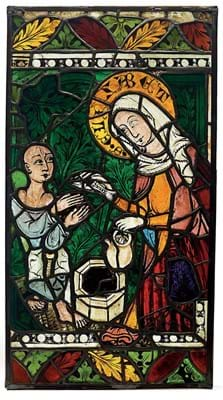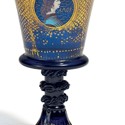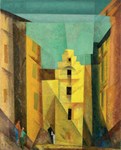Van Ham (28% buyer’s premium) had a 6in (16cm) high, part gilt and enamelled blue glass goblet (right) to offer in a sale on November 19.
The gilding was somewhat worn, but three enamel painted medallions on the side were still in good condition. They depicted portraits of a noble couple and the inscription Amor Mio.
According to an old collector’s label on the base, the glass had once belonged to a church in the Swiss canton of Saint Gallen.
The auctioneers catalogued it as Venetian, but the in-house experts and the others they consulted could not agree on how to date it. They finally chose “presumably about 1500” but with a cautious guide price of €1500-2500.
Early specimens of the world-famous art of Venetian glass making can command a premium whenever good examples come up for sale. On auction day it soon became clear that plenty of bidders were more convinced than the auctioneers. Furious action developed in the room and on the phones and eventually the glass was knocked down for €110,000 (£91,665).
According to the auctioneer, the buyer was more than overjoyed at his success, crying out “no guts, no glory” when the hammer fell.
Earlier craftsman
The work of an earlier, medieval glass craftsman also dramatically outstripped modest expectations at Lempertz’s (24% buyer’s premium) sale the day before.
An 1ft 11in x 13in (60 x 33cm) fragment of a 13th or 14th century stained-glass window (left) had belonged to a German collector since the 1950s, when it was last sold in the same rooms. He or his descendants consigned it for sale once more.
The glass panel, originally part of a larger church window, depicted St Elizabeth caring for the needy and was decorated in colours and with schwarzlot painting. The lead frames were replacements, which partly explains the restrained estimate of €3000-4000.
In the event, international interest emerged, but a German collector was the most determined participant and he sealed the deal at €66,000 (£55,000).












